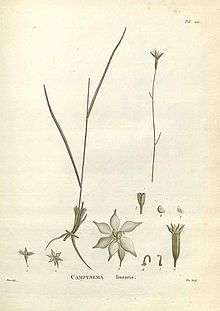Campynemataceae
| Campynemataceae | |
|---|---|
 | |
| Campynema lineare Labill. | |
| Scientific classification | |
| Kingdom: | Plantae |
| Clade: | Angiosperms |
| Clade: | Monocots |
| Order: | Liliales |
| Family: | Campynemataceae Dumort.[1] |
| Type species | |
| Campynema lineare | |
| Genera | |
| Synonyms | |
Campynemataceae (Campynemaceae) is a family of flowering plants. The family consists of two genera and four species[5] of perennial herbaceous plants endemic to New Caledonia and Tasmania.
Taxonomy
Originally described by Dumortier in 1829, Campynemaceae consisted of a single genus, Campynema, described by Labillardière in Tasmania in 1804. In 1893 Baillon identified a closely related genus, Campynemanthe in New Caledonia.[6] Together the two genera make up the family Campynemataceae sensu Angiosperm Phylogeny Group (APG), within the Liliales order.[7]
While historically, the two genera have generally been treated together, their circumscription has varied considerably. The third edition (1903) of Engler's Syllabus only included Campynema, but positioned it as Campynematoideae, a subfamily of Amaryllidaceae.[4]
Phylogeny
The synthesis of molecular data with cladistic analysis suggests that the Liliales form one of eleven orders of monocotyledons.[8] Sequencing of the rbcL and trnL-F plastid genes revealed four main Liliales lineages:[9]
- Liliaceae group: Liliaceae (including some former Uvulariaceae and Calochortaceae), Philesiaceae and Smilacaceae;
- Campynemataceae;
- Colchicaceae group (Colchicoid lilies): Colchicaceae (including Petermannia and Uvularia), Alstroemeriaceae and Luzuriaga;
- Melanthiaceae (including Trilliaceae).
This suggested that the Campynemataceae form one of seven families within the Liliales order.
| Liliales |
| ||||||||||||||||||||||||||||||||||||||||||||||||||||||
References
- 1 2 Dumortier 1829, Campynemaceae p. 58.
- ↑ Dahlgren, Clifford & Yeo 1985, pp. 213–214.
- ↑ Dahlgren & Lu 1985.
- 1 2 Engler 1903, Campynematoideae p. 99.
- ↑ Christenhusz, M. J. M.; Byng, J. W. (2016). "The number of known plants species in the world and its annual increase". Phytotaxa. Magnolia Press. 261 (3): 201–217. doi:10.11646/phytotaxa.261.3.1.
- ↑ Baillon 1893.
- ↑ APG III 2009.
- ↑ Meerow 2012.
- ↑ Rudall et al. 2000.
Bibliography
- Dahlgren, Rolf M.; Clifford, H. T.; Yeo, Peter (1985). The families of the monocotyledons: Structure, evolution, and taxonomy. Berlin and New York: Springer-Verlag. ISBN 978-3-642-64903-5. Retrieved 10 February 2014. Additional excerpts
- Dahlgren, Rolf; Lu, An-ming (1985). "Campynemanthe (Campynemaceae): Morphology, microsporogenesis, early ovule ontogeny and relationships". Nordic Journal of Botany. 5 (4): 321–330. doi:10.1111/j.1756-1051.1985.tb01660.x.
- Kubitzki, Klaus. Campynemataceae. pp. 173–175. , in Kubitzki & Huber (1998)
- Kubitzki, Klaus; Huber, Herbert, eds. (1998). The families and genera of vascular plants. Vol.3. Flowering plants. Monocotyledons: Lilianae (except Orchidaceae). Berlin, Germany: Springer-Verlag. ISBN 3-540-64060-6. Retrieved 14 January 2014.
- Dumortier, Barthélemy-Charles (1829). Analyse des familles des plantes :avec l'indication des principaux genres qui s'y rattachent (in French). Tournay: Casterman. Retrieved 16 January 2016.
- APG III (2009). "An Update of the Angiosperm Phylogeny Group classification for the orders and families of flowering plants: APG III". Botanical Journal of the Linnean Society. 161 (2): 105–121. doi:10.1111/j.1095-8339.2009.00996.x. Retrieved 3 January 2014.
- Baillon, M. H. (1 November 1893). "L'organisation et les affinités des Campynémées". Bulletin mensuel de la Société linnéenne de Paris (in French). 2 (140): 1105–1109.
- Engler, Adolf (1903) [1892]. Syllabus der Pflanzenfamilien: eine Übersicht über das gesamte Pflanzensystem mit Berücksichtigung der Medicinal- und Nutzpflanzen nebst einer Übersicht über die Florenreiche und Florengebiete der Erde zum Gebrauch bei Vorlesungen und Studien über specielle und medicinisch-pharmaceutische Botanik (3rd ed.). Berlin: Gebrüder Borntraeger Verlag. p. 233. Retrieved 31 January 2014.
- Goldblatt, Peter (1986). "Systematics and relationships of the bigeneric Pacific family Campynemataceae (Liliales)". Bulletin Du Museum National D'Histoire Naturelle Section B Adansonia Botanique Phytochimie. 8: 117–132.
- Meerow, A.W. Taxonomy and Phylogeny: Liliaceae. pp. 17–55. In Kamenetsky & Okubo (2012)
- Rudall, P. J.; Stobart, K. L.; Hong, W-P.; Conran, J. G.; Furness, C. A.; Kite, G. C.; Chase, M. W. Consider the lilies: systematics of Liliales. pp. 347–359. Retrieved 14 January 2014. In Wilson & Morrison (2000)
- Kamenetsky, Rina; Okubo, Hiroshi, eds. (2012). Ornamental Geophytes: From Basic Science to Sustainable Production. CRC Press. ISBN 1-4398-4924-2.
- Wilson, K. L.; Morrison, D. A., eds. (2000). Monocots: Systematics and evolution (Proceedings of the Second International Conference on the Comparative Biology of the Monocotyledons, Sydney, Australia 1998). Collingwood, Australia: CSIRO. ISBN 0-643-06437-0. Retrieved 14 January 2014. Excerpts
External links
| Wikispecies has information related to Campynemataceae |
- Campynemataceae in L. Watson and M.J. Dallwitz (1992 onwards). The families of flowering plants: descriptions, illustrations, identification, information retrieval. Version: 9 March 2006. https://web.archive.org/web/20070103200438/http://delta-intkey.com/
- NCBI Taxonomy Browser